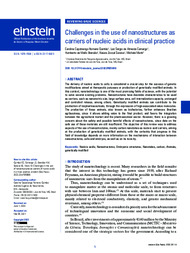Challenges in the use of nanostructures as carriers of nucleic acids in clinical practice.
Challenges in the use of nanostructures as carriers of nucleic acids in clinical practice.
Author(s): QUINTAO, C. C. R.; CAMARGO, L. S. de A.; BRANDAO, H. de M.; SARAIVA, N. Z.; MUNK, M.
Summary: The delivery of nucleic acids to cells is considered a crucial step for the success of genetic modifications aimed at therapeutic purposes or production of genetically modified animals. In this context, nanotechnology is one of the most promising fields of science, with the potential to solve several existing problems. Nanostructures have desirable characteristics to be used as carriers, such as nanometric size, large surface area, cell internalization capacity, prolonged and controlled release, among others. Genetically modified animals can contribute to the production of biopharmaceuticals, through the expression of high-associated-value molecules. The production of these animals, also known as biofactories, further enhances Brazilian agribusiness, since it allows adding value to the final product, and favors the integration between the agricultural market and the pharmaceutical sector. However, there is a growing concern about the safety and possible harmful effects of nanostructures, since data on the safe use of these materials are still insufficient. The objective of this review was to address aspects of the use of nanostructures, mainly carbon nanotubes as nucleic acid carriers, aiming at the production of genetically modified animals, with the certainty that progress in this field of knowledge depends on more information on the mechanisms of interaction between nanostructures, cells and embryos, as well as on its toxicity.
Publication year: 2022
Types of publication: Journal article
Unit: Embrapa Dairy Cattle
Observation
Some of Embrapa's publications are published as ePub files. To read them, use or download one of the following free software options to your computer or mobile device. Android: Google Play Books; IOS: iBooks; Windows and Linux: Calibre.
Access other publications
Access the Agricultural Research Database (BDPA) to consult Embrapa's full library collection and records.
Visit Embrapa Bookstore to purchase books and other publications sold by Embrapa.

